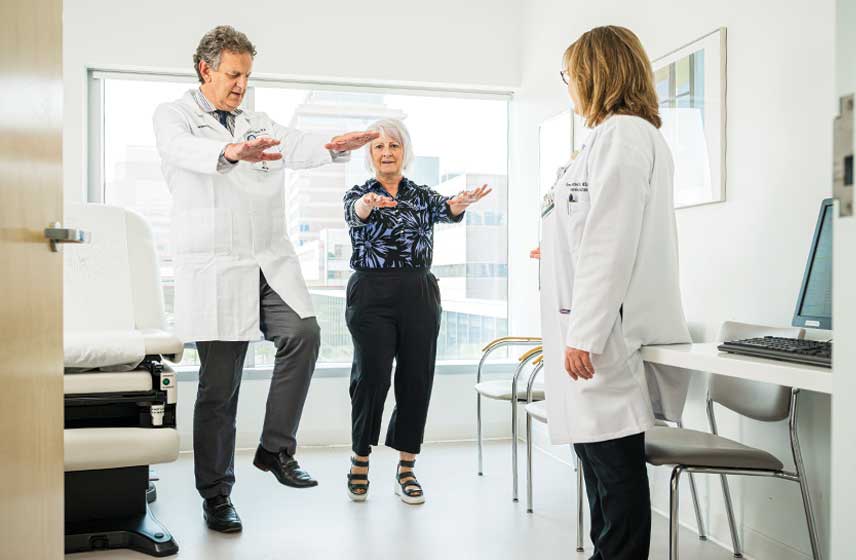
Chiari Malformation
Chiari malformation, an abnormal skull base that forms before birth, may be at fault. The bony area can push part of your brain into your spinal canal. And while symptoms often show up in childhood, that’s not always the case.
This diagnosis may come as a surprise — especially if you’ve spent much of your life symptom-free. At Cleveland Clinic, our expert neurology providers can help you understand what it all means and what to expect from treatment. We want you to feel comfortable and confident about taking the next step.
Why Choose Cleveland Clinic for Chiari Malformation Care?
Caring approach:
Hearing you have a brain condition like Chiari malformation probably isn’t the diagnosis you expected. As you prepare to start treatment, you may feel stressed, anxious and unsettled. That’s OK. Our team is here to help ease your mind as much as possible. We listen to you and answer your questions, so the future doesn’t seem so unknown.
Trusted experts:
Cleveland Clinic has a large team of expert healthcare providers dedicated to treating neurological conditions. Our neurology providers are nationally recognized for their skills and knowledge. And they work together to make sure you always stay at the center of your care. Meet our team.
Comprehensive care:
From watchful waiting and regular testing to the latest surgery techniques, our team has the care you need when you’re diagnosed with a neurological condition. We make sure we personalize your treatment plan to your unique diagnosis and needs.
Virtual visits:
Life moves fast. And time is valuable. So, when you want to have a quick check-in with your provider, why not try a virtual visit? Meet one-on-one with your provider online and get the same great care and attention as you would in person.
National recognition:
Cleveland Clinic is a trusted healthcare leader. We're recognized in the U.S. and throughout the world for our expertise and care.
Diagnosing Chiari Malformation at Cleveland Clinic
Until you started having headaches and feeling a little off balance, you never would have dreamed there was problem with your skull. But if you’re diagnosed with Chiari malformation, it’s important to understand you’ve had this condition since birth.
Some things to know about Chiari malformation
Chiari malformation starts during fetal development. With this condition, your skull base doesn’t form the way it should (structural problem or malformation), meaning it can be misshapen or too small. If this happens, a part of your brain called the cerebellum can get squeezed (compressed) and pushed out of the protective skull.
Some babies have immediate signs of this condition — problems with movement, posture, balance, coordination, hearing and speech. Other people may not show signs until childhood, their teen years or even adulthood. Some may never have symptoms and learn about this condition when they have testing for another reason.
There are different types of Chiari malformations. The main ones are:
- Chiari malformation type I: In this most common type, the cerebellum passes through the hole at the skull’s base (foramen magnum). This is where the spinal cord usually goes. If you’re diagnosed with this type of malformation, you may not have symptoms. Or you might not notice them until adulthood.
- Chiari malformation type II: A complex malformation keeps the backbone and spinal canal from closing before birth. This is a form of spina bifida called myelomeningocele.
- Chiari malformation type III: The rarest, most severe Chiari malformation shows up early in life. It happens when both the cerebellum and the brain stem go through an abnormal opening in the skull. This causes swelling called encephalocele.
What to expect at your first visit
When you come to your appointment, your provider will want to talk with you about your symptoms. What they are. How long you’ve had them. How they’re affecting your life. They’ll do a physical exam to check your overall health, as well.
You’ll also have a neurological exam. Your provider will have you move and balance. They might check how well you feel things in your hands and feet. And they may do tests to see if you have any challenges with your memory or any difficulties with thinking. They’ll also order imaging tests to rule out other conditions and confirm a diagnosis.
Imaging tests for Chiari malformation
Imaging tests give your providers a close look at your brain and skull from the inside. And lets our team look at your brain, spinal cord and skull. They can see how far the cerebellum is in the spinal canal. A similar test, the cine MRI lets providers see how spinal fluid flows around the base of your skull. You may also have a CT scan or X-rays.
Meet Our Chiari Malformation Team
At Cleveland Clinic, we believe in the power of teamwork when it comes to offering the best care. That’s why you’ll have a personalized care team of providers from many specialties working together, like:
This larger group of providers will build your treatment plan and help manage your care. They meet regularly with each other and you to make sure treatment is effective.
Providers Who Treat Chiari Malformation
Locations
Our healthcare providers see patients at convenient locations throughout Northeast Ohio, Florida and London.Treating Chiari Malformation at Cleveland Clinic
Our team tailors your treatment to your needs. If you have no symptoms or mild ones, we may do watchful waiting. This means you’ll have regular checkups with your care team and MRIs to see if your condition is getting worse. For more severe Chiari malformations, surgery is the main treatment. There are several different types of surgery, including:
Posterior fossa decompression
This is the most common surgery for Chiari malformation. During this procedure, surgeons remove a part of the skull called the posterior fossa. The goal with this is to relieve pressure on your brain.
Laminectomy
Your surgical team may also need to remove some bone covering your spinal column. This helps spinal fluid flow better. It also makes more room for your spinal cord.
Duraplasty
Your brain has an outer membrane called the dura. Surgeons can open the dura and expand it with a patch. This gives your brain more room and reduces pressure on it.
Electrocautery
We can use electrocauterization to make more room in your skull so spinal fluid can drain better. We do this by shrinking a small section of the brain with a small amount of electricity. It doesn’t cause any neurological damage.
Taking the Next Step
You may feel a bit blindsided when those headaches turn out to be a brain condition that might need surgery. But when you get Chiari malformation treatment from Cleveland Clinic’s experienced neurology team, you can take a deep breath knowing you have the best team on your side. Our experienced and caring providers are here to support you from the moment you schedule your first appointment. Throughout it all we’ll be by your side, answering all your questions and guiding you through your personalized care plan.
Appointments
Getting an appointment with Cleveland Clinic’s Chiari malformation experts is easy. We’ll help you get the care you need.
Billing & Insurance
Manage your Cleveland Clinic account. Find billing information and financial assistance, plus FAQs.
MyChart
Securely access your personal health information at any time, day or night.

